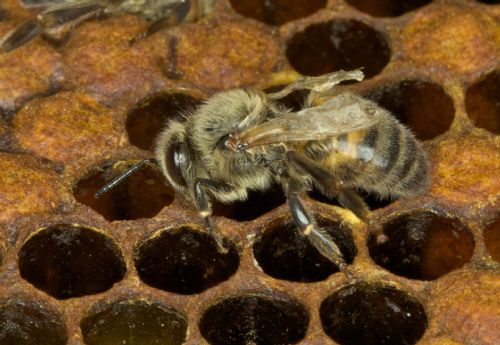
Bees risk being exposed to a range of diseases that can be transferred by varroa mites. Scientists from Aarhus University are investigating the interaction between mite infection, virus infection and disease outbreak in bees.
In an existence in which the days are passed by producing honey, one would suppose that bees live the sweet life. However, they do have their share of problems. One of them is the battle against disease. Bees can be infected by mites that carry viruses that can cause disease or even death in bee colonies. Scientists from Aarhus University are exploring several avenues in order to find effective solutions to the problem.
This spring, the scientists have started a new project in which they will study the interaction between the incidence of mites, virus infection, and disease in the bees. Among other things, the scientists will investigate how many mites in a bee family are necessary to overcome the bees’ threshold for an outbreak of virus disease.
The mites in question are the so-called varroa mites. Varroa mites infest bee brood and make the pupae more susceptible to virus infections. Varroa mites are a major problem for Danish beekeepers.
In order to control varroa mites in beehives, some beekeepers use organic acids such as formic acid and oxalic acid. Another method is to use flumethrin, which is a synthetic form of pyrethroid. Some beekeepers also remove the drone broods during the summer in order to control the spread of the mites.
Bees in the laboratory
From 1 April until 1 October hundreds of bees will be studied more closely in the laboratory at Aarhus University.
Each month during the period, the scientists will receive live bees from 12 different beekeepers using various mite control methods. The bees will be investigated for the occurrence of mites. Both bees and mites will be investigated for the presence of virus.
The university’s own bees, which have not been treated against mites, will act as the control group. These bees are already infected by varroa mites, some of them even so seriously that the bee family is clearly weakened. By comparing the number of mites with how easy it is to detect symptoms of virus disease in the bees the scientists expect to be able to discover a tool that can be used in practice.
One of the viruses that varroa mites transfer is deformed wing virus (DWV). When bees with deformed or missing wings are found it is a sign that it is time to control the varroa mites. It would be even better if control could be started earlier so that the transfer of serious virus diseases could be avoided.
- Mite populations grow exponentially which means that they double their number once a month. It is therefore important to know how early on it is advisable to start controlling the mites to save the bee family. Our goal is to be able to use the results from the investigation to offer even better advice to beekeepers about when their bees should be treated against varroa mites, says senior scientist Per Kryger from the Department of Integrated Pest Management and one of the scientists involved in the project.
The project is supported by EU’s honey programme, the Ministry of Food, Agriculture and Fisheries, and the Danish beekeeper associations.
